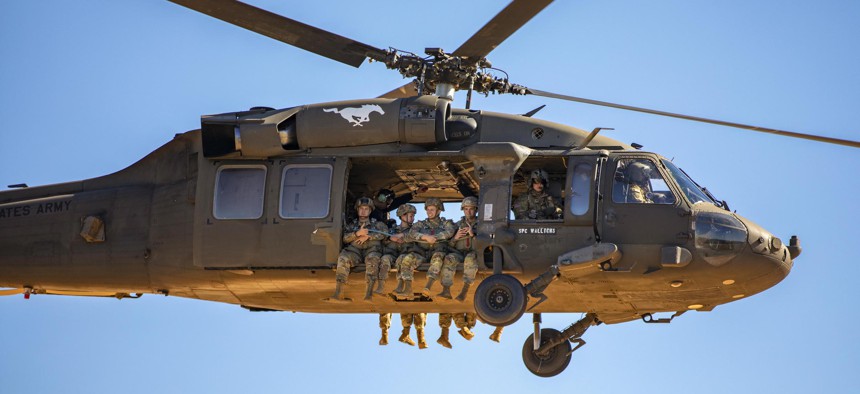
A Nov. 8, 2021, photo of soldiers participating in the annual Saint Michael's Jump, honoring the patron saint of the 82nd Airborne Division, at Fort Bragg, N.C. U.S. Army / Army Pfc. Vincent Levelev
Pentagon Names Army Units Tapped for Possible European Deployment
Defense spokesman cautions that these units have only been alerted, not activated, as tensions continue around Ukraine.
Soldiers from the Army’s elite airborne divisions are among the 8,500 service members currently on heightened alert to rapidly deploy if NATO activates its multinational response force, the Pentagon announced Thursday.
“These forces are on a heightened preparedness to deploy. They have not been activated,” Pentagon spokesman John Kirby emphasized during a news conference. “The vast majority of the troops that the [defense] secretary put on prepare to deploy are in fact dedicated to the NATO Response Force. And if and when they're activated, we'll be able to provide more specific detail in terms of breakdowns in numbers.”
Russia has been assembling military equipment and more than 100,000 troops along the Ukrainian border for months; recent additions include medical units. Ukrainian leaders have tried to temper its citizens’ concerns that Moscow, which illegally annexed Ukraine’s Crimea in 2014, might invade at any moment while U.S. government officials continue to state an incursion could be “imminent.”
“We still believe there's time and space for diplomacy, but thus far it has not achieved the kind of results that the international community would like to see. All that combined has led us to, again, want to contribute more capabilities to Ukrainian armed forces and be ready to contribute more capabilities to our NATO allies,” Kirby said Thursday.
Kirby said units that had been put on alert include parts of the 82nd Airborne Division and the XVIII Airborne Corps at Fort Bragg, North Carolina. These forces already maintain a high level of readiness due to their mission to quickly deploy around the world, as they did during the Afghanistan airlift effort last August.
Other units put on alert include parts of the 4th Infantry Division and other units at Fort Carson, Colorado; parts of the 101st Airborne Division and the XVIII Airborne Corps at Fort Campbell, Kentucky; and units at Davis-Monthan Air Force Base, Arizona; Fort Hood, Texas; Joint Base Lewis-McChord, Washington state; Fort Polk, Louisiana; Robins Air Force Base, Georgia; Fort Stewart, Georgia; Wright-Patterson Air Force Base, Ohio; as well as several other unnamed U.S. locations.
The units include logistics, medical, aviation, transportation, and intelligence and surveillance support elements. Placing these troops on heightened alert is meant to reduce the response time to deploy, so for some units that means going from 10 to five days, Kirby said previously.
Kirby would not rule out that additional U.S. troops already in Europe—some on rotational deployments and others stationed there permanently—could be called up to help.
“I believe that Gen. [Tod] Wolters is taking prudent steps to make sure that if we need to move forces from inside Europe to other places in Europe and allied territory, that he's ready to do that,” Kirby said.
Wolters leads U.S. European Commander and is NATO’s Supreme Allied Commander Europe, capable of moving troops throughout the region. These additional troops could be sent to NATO’s eastern flank: Estonia, Lithuania, Latvia, and Poland.
